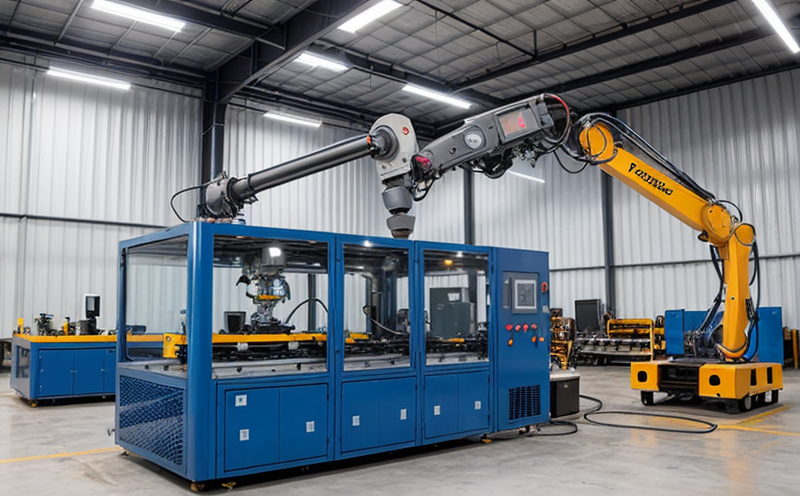ISO 31000 Risk Management Testing in Robotics Systems
The implementation of industrial robotics and automation systems has revolutionized manufacturing processes across various sectors. However, these advanced technologies come with unique risks that need to be identified, assessed, and managed effectively. ISO 31000 provides a comprehensive framework for risk management tailored to the specific context of industrial robotics systems.
ISO 31000 Risk Management Testing in Robotics Systems involves a systematic approach to identify potential hazards associated with robotic operations, assess their likelihood and impact on human safety, equipment integrity, operational efficiency, and environmental factors. This process ensures that risks are minimized or mitigated before they lead to adverse outcomes.
The testing procedure follows the ISO 31000 standard, which outlines a structured methodology for risk identification, analysis, evaluation, treatment, monitoring, review, and communication. For robotics systems, this includes:
- Identification of potential risks during design, installation, commissioning, operation, maintenance, and decommissioning.
- Evaluation of the likelihood and impact on human safety, equipment integrity, operational efficiency, and environmental factors.
- Development of risk treatment plans to minimize or mitigate identified risks.
- Ongoing monitoring and review of implemented measures to ensure their effectiveness.
This testing is critical for ensuring compliance with international standards such as ISO 31000, which provides a robust framework for managing risks in complex systems like robotics. By adhering to this standard, manufacturers can enhance safety, improve operational efficiency, and reduce potential liabilities associated with robotic operations.
The test parameters involve detailed analysis of the system's components, including sensors, actuators, controllers, software, and communication protocols. Specimen preparation focuses on simulating real-world scenarios to assess the system's response under various conditions. Instrumentation includes specialized tools for monitoring performance metrics such as speed, accuracy, reliability, and energy consumption.
The reporting process adheres strictly to ISO 31000 guidelines, ensuring that all findings are documented comprehensively. This includes risk matrices, hazard identification lists, likelihood and impact assessments, treatment plans, and continuous improvement strategies. The reports serve as valuable resources for decision-makers in optimizing robotic systems and enhancing overall safety protocols.
By leveraging ISO 31000 Risk Management Testing in Robotics Systems, organizations can establish a proactive approach to risk management that aligns with best practices globally. This ensures not only regulatory compliance but also contributes significantly to operational excellence and sustained growth within the industrial sector.
Benefits
The benefits of implementing ISO 31000 Risk Management Testing in Robotics Systems are multifaceted, offering significant advantages across various dimensions:
- Safety Enhancement: Identifying and mitigating risks ensures that robotic systems operate safely, reducing the likelihood of accidents or injuries.
- Operational Efficiency: By optimizing system performance through risk management, operations become more efficient and productive.
- Compliance Assurance: Adhering to international standards like ISO 31000 ensures compliance with regulatory requirements, minimizing legal risks.
- Risk Mitigation: Early identification of potential issues allows for proactive measures, reducing the impact of unforeseen events.
- Cost Savings: Preventive maintenance and risk management strategies can lead to significant cost savings by avoiding costly repairs and replacements.
- Sustained Performance: Continuous monitoring and review ensure that robotic systems maintain optimal performance over their lifecycle.
In summary, ISO 31000 Risk Management Testing in Robotics Systems offers a holistic approach to managing risks, enhancing safety, improving operational efficiency, ensuring compliance, mitigating risks, saving costs, and sustaining high-performance levels. These benefits are crucial for organizations aiming to maximize their investment in industrial robotics while minimizing potential hazards.
Industry Applications
The application of ISO 31000 Risk Management Testing in Robotics Systems is broad and spans multiple industries, each with its unique challenges and requirements. Here are some key sectors where this testing plays a critical role:
- Automotive Manufacturing: Ensuring the safety and reliability of robotic systems used in assembly lines.
- Pharmaceuticals: Maintaining strict adherence to regulatory standards for automated processes in drug production.
- Aerospace: Testing robotic systems that are critical for precision manufacturing and quality control.
- Petrochemicals: Evaluating the robustness of robotic systems in hazardous environments, ensuring safety and compliance with stringent regulations.
- Electronics Manufacturing: Enhancing accuracy and reliability through systematic risk assessment and mitigation strategies.
- Logistics & Warehousing: Optimizing automated processes for storage, retrieval, and distribution in warehouses.
In each of these industries, the implementation of ISO 31000 Risk Management Testing ensures that robotic systems are not only efficient but also safe and compliant with international standards. This comprehensive approach helps organizations achieve their goals while minimizing potential risks.
Why Choose This Test
- Comprehensive Approach: ISO 31000 provides a structured and systematic framework for identifying, assessing, and managing risks in robotics systems.
- International Recognition: Adherence to this standard ensures compliance with global best practices and regulatory requirements.
- Proactive Risk Management: By addressing potential issues proactively, organizations can minimize the impact of unforeseen events.
- Data-Driven Decisions: The structured reporting process based on ISO 31000 allows for evidence-based decision-making.
- Purposeful Risk Treatment Plans: Developed treatment plans are tailored to specific risks, ensuring effective mitigation strategies.
- Sustained Performance: Continuous monitoring and review ensure that robotic systems maintain optimal performance over their lifecycle.
The ISO 31000 Risk Management Testing in Robotics Systems is a crucial step towards enhancing safety, improving operational efficiency, and ensuring compliance with international standards. By choosing this test, organizations can establish a robust risk management framework that supports sustainable growth and excellence within the industrial sector.





